Madonnas by Raphael
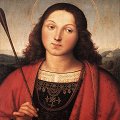 Raphael is an Italian High
Renaissance painter and architect of the Florentine school, celebrated
for the perfection and grace of his art. His work is
admired for its clarity of form and ease of composition and for its
visual achievement of the Neoplatonic ideal of human grandeur. Raphael
is one of the most famous artists of High Renaissance and one of the
greatest influences in the history of Western art.
Raphael is an Italian High
Renaissance painter and architect of the Florentine school, celebrated
for the perfection and grace of his art. His work is
admired for its clarity of form and ease of composition and for its
visual achievement of the Neoplatonic ideal of human grandeur. Raphael
is one of the most famous artists of High Renaissance and one of the
greatest influences in the history of Western art.
Paintings by Raphael
- Madonna and Child (1503)
- The Granduca Madonna (1504)
- Madonna and Child (The Ansidei Altarpiece) (1505)
- Madonna of Belvedere (Madonna del Prato) (1506)
- Madonna with Beardless St. Joseph (1506)
- Madonna del Cardellino (1507)
- The Canigiani Madonna (1507)
- The Virgin and Child with Saint John the Baptist (La Belle Jardiniere) (1507)
- Madonna and Child (The Large Cowper Madonna) (1508)
- Madonna del Baldacchino (1508)
- Madonna of Loreto (Madonna del Velo) (1510)
- The Madonna of Foligno (1512)
- Madonna dell'Impannata (1514)
- Madonna della Seggiola (Sedia) (1514)
- Madonna della Tenda (1514)
- The Sistine Madonna (1514)
Madonna and Child (1503)
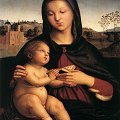 Get
Get  a high-quality picture of
Madonna and Child for your computer or notebook. ‣
The Madonna is holding the Christ Child with great tenderness. The two are also linked as they read the book of hours that is open at the prayer of Nones, the ninth hour after dawn in the Church's day. The hour of the Annunciation, when the Virgin conceived her son, the ninth hour was also the hour of His death on the Cross. Pausing from their reading, they look at each other thoughtfully, calmly meditating on the events to come.
a high-quality picture of
Madonna and Child for your computer or notebook. ‣
The Madonna is holding the Christ Child with great tenderness. The two are also linked as they read the book of hours that is open at the prayer of Nones, the ninth hour after dawn in the Church's day. The hour of the Annunciation, when the Virgin conceived her son, the ninth hour was also the hour of His death on the Cross. Pausing from their reading, they look at each other thoughtfully, calmly meditating on the events to come.
The Granduca Madonna (1504)
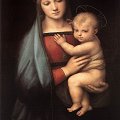 Get
Get  a high-quality picture of
The Granduca Madonna for your computer or notebook. ‣
The Madonna del Granduca (1504) in the Pitti Gallery in Florence shows the pre-eminent influence of Da Vinci. Its simple composition is a prototype for the future Madonnas of Raphael's last Florentine period. The figures of the Virgin and Child emerge from a dark background (an element evidently derived from Leonardo), bound together by a sweet sentiment which derives largely from the gesture of the Child who, while looking toward the spectator, presses against his Mother The painting belonged to the 17th century Florentine painter, Carlo Dolci, and then to Grand Duke Ferdinand III of Lorraine from whom its name derives.
a high-quality picture of
The Granduca Madonna for your computer or notebook. ‣
The Madonna del Granduca (1504) in the Pitti Gallery in Florence shows the pre-eminent influence of Da Vinci. Its simple composition is a prototype for the future Madonnas of Raphael's last Florentine period. The figures of the Virgin and Child emerge from a dark background (an element evidently derived from Leonardo), bound together by a sweet sentiment which derives largely from the gesture of the Child who, while looking toward the spectator, presses against his Mother The painting belonged to the 17th century Florentine painter, Carlo Dolci, and then to Grand Duke Ferdinand III of Lorraine from whom its name derives.
In spite of the fact that this painting is in part changed by the drastic nineteenth century restoration which included the repainting of the background and of the dress, it has still remained one of the finest creations of Raphael in his early period, at the time, when having come to Florence after his first formation under Perugino, he became acquainted with Florentine art at the beginning of the Cinquecento; and as is clearly seen in this work, was especially impressed by the painting of Da Vinci. In the Madonna del Granduca both the Peruginesque and the Leonardesque influences are fused and assimilated by the young artist into a marvellous harmony which extends to the whole composition, from the spacing of the two figures in the space with that sense of flowing rhythm to the magic of the colour which softly dissolves into delicate shadow.
Raphael's greatest paintings seem so effortless that one does not usually connect them with the idea of hard and relentless work. To many he is simply the painter of sweet Madonnas which have become so well known as hardly to be appreciated as paintings any more. For Raphael's vision of the Holy Virgin has been adopted by subsequent generations in the same way as Michelangelo's conception of God the Father We see cheap reproductions of these works in humble dwellings, and we are apt to conclude that paintings with such a general appeal must surely be a little 'obvious'. In fact, their apparent simplicity is the fruit of deep thought, careful planning and immense artistic wisdom. A painting like Raphael's 'Madonna dell Granduca', is truly 'classical' in the sense that it has served countless generations as a standard of perfection in the same way as the works of Pheidias and Praxiteles. It needs no explanation. In this respect it is indeed 'obvious'. But, if we compare it with the countless representations of the same theme which preceded it, we feel that they have all been groping for the very simplicity that Raphael has attained. We can see what Raphael did owe to the calm beauty of Perugino's types, but what a difference there is between the rather empty regularity of the master and the fullness of life in the pupil! The way the Virgin's face is modeled and recedes into the shade, the way Raphael makes us feel the volume of the body wrapped in the freely flowing mantle, the firm and tender way in which she holds and supports the Christ Child - all this contributes to the effect of perfect poise. We feel that to change the group ever so slightly would upset the whole harmony. Yet there is nothing strained or sophisticated in the composition. It looks as if it could not be otherwise, and as if it had so existed from the beginning of time.
Madonna and Child (The Ansidei Altarpiece) (1505)
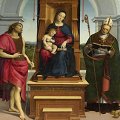 Get
Get  a high-quality picture of
Madonna and Child (The Ansidei Altarpiece) for your computer or notebook. ‣
Raphael abandoned every trace of Peruginesque influence in Florence and returned to Umbria in the same year with new pictorial motifs which he was to express in two notable works, the Colonna Altarpiece and, a bit later, the Ansidei Madonna, also known as the Enthroned Madonna with Saints John the Baptist and Nicholas of Bari.
a high-quality picture of
Madonna and Child (The Ansidei Altarpiece) for your computer or notebook. ‣
Raphael abandoned every trace of Peruginesque influence in Florence and returned to Umbria in the same year with new pictorial motifs which he was to express in two notable works, the Colonna Altarpiece and, a bit later, the Ansidei Madonna, also known as the Enthroned Madonna with Saints John the Baptist and Nicholas of Bari.
The Ansidei altarpiece, of a type known as sacra conversazione (Italian for `holy conversation'), in which the enthroned Virgin and Child and their attendant saints seem to commune together, was commissioned by Bernardino Ansidei for his family chapel in a Perugian church. The chapel was dedicated to Saint Nicholas of Bari, and the bishop saint is shown with his attribute of three golden balls (the origin of pawnbrokers' signs) representing the bags of gold he donated as dowries to three poor girls. John the Baptist, who foretold the coming of Christ and baptised him, wears the camel tunic of his desert sojourn and a crimson prophet's cloak. Instead of his usual reed cross, he holds a wonderfully transparent cross of crystal. Pointing to the Child on the Virgin's lap, he looks up gravely to the Latin inscription above her, `Hail, Mother of Christ'. Beads of scarlet coral, a common charm against evil, the colour of Christ's blood, hang from the canopy. The vaulted niche open onto the luminous Umbrian countryside was designed to seem continuous with the actual architecture of the chapel.
The luminous landscape background and the high baldachin remotely recall the art of Piero della Francesca, but the figure types, still vaguely Peruginesque in their contours, are psychologically more complex and structurally more volumetric. The compositional scheme is reduced to a large arch whose central axis is represented by the baldachin. The result is a sense of monumentality and harmonic proportion which were to become constant in Raphael's art.
One of the three predella panels for this altarpiece survives and is also in the National Gallery, Saint John the Baptist Preaching, which must have been placed to the left, beneath the figure of the saint. Below the Virgin and Child there was once a scene of the Marriage of the Virgin, and Saint Nicholas saving the Lives of Seafarers originally supported Nicholas's image on the right.
Madonna of Belvedere (Madonna del Prato) (1506)
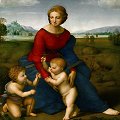 Get
Get  a high-quality picture of
Madonna of Belvedere (Madonna del Prato) for your computer or notebook. ‣
The Madonna of the Meadow is the first of a series of full-length figure compositions that portray the apocryphal encounter between the Child Jesus and the boy Baptist. The boy Baptist is supposed to have recognized and worshipped Christ as the Redeemer even in their childhood. Raphael makes this clear by letting Christ take the cross from John.
a high-quality picture of
Madonna of Belvedere (Madonna del Prato) for your computer or notebook. ‣
The Madonna of the Meadow is the first of a series of full-length figure compositions that portray the apocryphal encounter between the Child Jesus and the boy Baptist. The boy Baptist is supposed to have recognized and worshipped Christ as the Redeemer even in their childhood. Raphael makes this clear by letting Christ take the cross from John.
Michelangelo's influence on Raphael is evident in this composition. The pyramidal structure of the figure group recalls Leonardo (whose cartoon for the St Anne was shown in 1506 in the Church of Santissima Annunziata). But Raphael exerts his own balancing capacity on the Leonardesque volumetric conception, infusing it with the idyllic serenity which characterizes his paintings from this period. The work as a whole is structurally harmonic, from the figure group (dominated by the affectionate figure of the Virgin Mary who supports the Child and glances tenderly at the young St John) to the sweeping landscape (made luminous by the mirror-like lake which stretches from one side of the panel to the other). The twisting figures of the two children clearly reflect Michelangelo's figurative research.
Madonna with Beardless St. Joseph (1506)
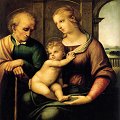 Get
Get  a high-quality picture of
Madonna with Beardless St. Joseph for your computer or notebook. ‣
One of Raphael's version of the Holy Family. Its pecularity is the beardless representation of the traditionally bearded St Joseph. It can be assumed that this is one of the two paintings, mentioned by Vasari, which were executed in Urbino for Giodobaldo da Montrefeltro.
a high-quality picture of
Madonna with Beardless St. Joseph for your computer or notebook. ‣
One of Raphael's version of the Holy Family. Its pecularity is the beardless representation of the traditionally bearded St Joseph. It can be assumed that this is one of the two paintings, mentioned by Vasari, which were executed in Urbino for Giodobaldo da Montrefeltro.
Madonna del Cardellino (1507)
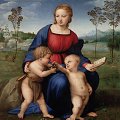 Get
Get  a high-quality picture of
Madonna del Cardellino for your computer or notebook. ‣
The Madonna of the Goldfinch, one of Raphael's Florentine panels, was painted by Raphael for the marriage of his friend Lorenzo Nasi and Sandra di Matteo di Giovanni Canigiani. It was severely damaged following the partial collapse of the Nasi house in 1547, as mentioned by Vasari. It was subsequently restored by Ridolfo del Ghirlandaio, the son of the artist who was deeply influenced by Raphael.
a high-quality picture of
Madonna del Cardellino for your computer or notebook. ‣
The Madonna of the Goldfinch, one of Raphael's Florentine panels, was painted by Raphael for the marriage of his friend Lorenzo Nasi and Sandra di Matteo di Giovanni Canigiani. It was severely damaged following the partial collapse of the Nasi house in 1547, as mentioned by Vasari. It was subsequently restored by Ridolfo del Ghirlandaio, the son of the artist who was deeply influenced by Raphael.
The Christ Child is lovingly stroking a goldfinch that the boy Baptist has just given him. A symbol of the Passion (the goldfinch, because it feeds among thorns) is thus combined in a scene that can at a first level of meaning be seen simply as children at play.
The composition follows that of the Madonna of the Meadow, with the essential difference that the children in the Madonna of the Goldfinch are more firmly united with the central figure of the Virgin. The colour is more lively than that of the Madonna of the Meadow and foreshadows the colourist character of Raphael's Roman paintings. The landscape, and particularly the architectural forms it contains, reflects the influence of Flemish art, even though it is still structured in the Umbrian manner This influence was as alive in Florence as it was in Urbino in the second half of the Quattrocento. It is perhaps most visible in the sloping roofs and tall spires, unusual elements in a Mediterranean landscape. The influence of Michelangelo is again evident in the well structured figure of the infant Christ. It was to become even more evident in the works which followed.
The Canigiani Madonna (1507)
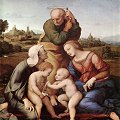 Get
Get  a high-quality picture of
The Canigiani Madonna for your computer or notebook. ‣
The Canigiani Holy Family in Munich is attributed to the same period as the Entombment (1504-1506). The painting's name derives from the Florentine family who owned it before it passed into the Medici collection and then into Germany with the marriage of Anna Maria Lodovica de' Medici to the Palatine Elector.
a high-quality picture of
The Canigiani Madonna for your computer or notebook. ‣
The Canigiani Holy Family in Munich is attributed to the same period as the Entombment (1504-1506). The painting's name derives from the Florentine family who owned it before it passed into the Medici collection and then into Germany with the marriage of Anna Maria Lodovica de' Medici to the Palatine Elector.
The Virgin and Elizabeth are sitting on the grass with their children, and Joseph is standing over them - this shows the importance of Jesus' adoptive father, and gives expression to the increase in the worship of Joseph after 1500. In 1982 the German conservator Hubert von Sonnenburg undertook a careful restoration of this picture and removed a distorting blue overpaint, dating from the 18th century, from the sky area. Raphael's original concept, with the putti on the upper left and right, can now be admired anew.
In this work Raphael synthesizes elements drawn from Da Vinci and Michelangelo and compounds them with a decisively Northern landscape and delicate colourist passages dominated by iridescent tones. The pyramid in which the figures are ideally enclosed is still drawn from models provided by Leonardo, but the relationships between the figures, developed through the glances they exchange and through the serene feelings they communicate, carry the composition onto a calmly descriptive plane. The tone of the painting is thus quite different from the tense and restless art of Da Vinci. His unsurpassed descriptive capacity permits Raphael to create an image full of human participation and limpid serenity.
The Virgin and Child with Saint John the Baptist (La Belle Jardiniere) (1507)
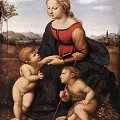 Get
Get  a high-quality picture of
The Virgin and Child with Saint John the Baptist (La Belle Jardiniere) for your computer or notebook. ‣
The so-called La Belle Jardiniere, now in the Louvre, is one of the several Madonna paintings executed by Raphael during his stay in Florence (1504-1508). It follows the Madonna of the Goldfinch (Uffizi, Florence) chronologically. Its composition is a mirror image of that of the Madonna of the Meadow (Kunsthistorisches Museum, Vienna). The painting was commissioned by Fabrizio Sergardi, a Sienese nobleman, and was left uncompleted by the artist. Nevertheless, it is signed and dated. According to tradition it was finished by Ridolfo del Ghirlandaio, although the recent restoration would seem to contradict this attribution. It was subsequently acquired by Francis I of France. The painting is known primarily for the harmonic and proportional balancing of the poses of the figures and for the high formal quality present in every element, particularly in the face of the Virgin, which served as a model of beauty for generations of artists.
a high-quality picture of
The Virgin and Child with Saint John the Baptist (La Belle Jardiniere) for your computer or notebook. ‣
The so-called La Belle Jardiniere, now in the Louvre, is one of the several Madonna paintings executed by Raphael during his stay in Florence (1504-1508). It follows the Madonna of the Goldfinch (Uffizi, Florence) chronologically. Its composition is a mirror image of that of the Madonna of the Meadow (Kunsthistorisches Museum, Vienna). The painting was commissioned by Fabrizio Sergardi, a Sienese nobleman, and was left uncompleted by the artist. Nevertheless, it is signed and dated. According to tradition it was finished by Ridolfo del Ghirlandaio, although the recent restoration would seem to contradict this attribution. It was subsequently acquired by Francis I of France. The painting is known primarily for the harmonic and proportional balancing of the poses of the figures and for the high formal quality present in every element, particularly in the face of the Virgin, which served as a model of beauty for generations of artists.
This painting is the highpoint of all Raphael's Florentine Madonnas. The bodies occupy the space with great freedom, while the figures interact with deep feeling. The arch formed by the frame completes the composition harmoniously. Raphael put the date of the picture into the hem of the Virgin's mantle, as he often did, but it is not clear if the Roman numerals are meant to be read as 1507 or 1508.
Madonna and Child (The Large Cowper Madonna) (1508)
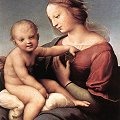 Get
Get  a high-quality picture of
Madonna and Child (The Large Cowper Madonna) for your computer or notebook. ‣
The dominance of the lyrical and graceful aspect of this painting (known also as The Niccolini-Cowper Madonna) over the religious content mark it as belonging to Raphael's Florentine period, 1505-08. In fact this panel, signed and dated 1508, was executed near the end of Raphael's stay in Florence. The date 1508 and the artist's monogram "RV" have been worked into the embroidery of the Virgin's robe. The title derives from the names of two former owners.
a high-quality picture of
Madonna and Child (The Large Cowper Madonna) for your computer or notebook. ‣
The dominance of the lyrical and graceful aspect of this painting (known also as The Niccolini-Cowper Madonna) over the religious content mark it as belonging to Raphael's Florentine period, 1505-08. In fact this panel, signed and dated 1508, was executed near the end of Raphael's stay in Florence. The date 1508 and the artist's monogram "RV" have been worked into the embroidery of the Virgin's robe. The title derives from the names of two former owners.
The full, well-formed figures reveal an early influence of Michelangelo, while the soft modeling and the use of chiaroscuro reveal the influence of Leonardo. Fra Bartolomeo's influence is particularly clear.
The composition is extremely simple and essential; the gesture of the Child, who stretches his hand toward the Virgin while turning his attention toward the spectator, and the gesture with which the Virgin holds the hand to her breast, provide the only signs of life. The sentiment of anxious motherhood which, enriched by greater awareness, will be fully expressed in the Tempi Madonna, now in the Alte Pinakothek of Munich, appears here for the first time.
Madonna del Baldacchino (1508)
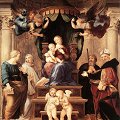 Get
Get  a high-quality picture of
Madonna del Baldacchino for your computer or notebook. ‣
The stylistic versatility which Raphael demonstrates in contemporary or nearly contemporary works executed for a homogeneous social environment is indicative of his extraordinary technical capacity. This versatility is expressed in a variety of compositional types, which can range from simple forms to more monumental and complex ones; and in conceptual expressions, which are sometimes calm and quiet and sometimes emphatic.
a high-quality picture of
Madonna del Baldacchino for your computer or notebook. ‣
The stylistic versatility which Raphael demonstrates in contemporary or nearly contemporary works executed for a homogeneous social environment is indicative of his extraordinary technical capacity. This versatility is expressed in a variety of compositional types, which can range from simple forms to more monumental and complex ones; and in conceptual expressions, which are sometimes calm and quiet and sometimes emphatic.
This range of figurative expressions appears in the Madonna del Baldacchino (Palazzo Pitti), a work from the Florentine period. This painting was begun in 1507 for the Dei family and was intended for their chapel in the Church of Santo Spirito. The panel's monumental structure derives partially from the Venetian tradition and partially from Fra Bartolomeo. The Venetian influence is visible above all in the setting: the apse of a church which recalls the larger compositions of Giovanni Bellini. The influence of Fra Bartolomeo consists mainly in the monumentality and poses of the figures. The semi-circular arrangement of the saints around the Virgin and the unusually excited flying angels who hold open the curtain of the baldachin give the painting a sense of free atmospheric circulation. The figures, all posed differently, prepare a complex of expressions which will find its natural outlet in the large descriptive compositions of the Vatican.
When Raphael went from Florence to Rome in 1508, this picture remained behind unfinished. The Virgin is enthroned beneath a baldacchino. St. Peter and St. Bernard are on the left, while St. Augustine, and probably St. James the Elder, stand on the right. The restoration carried out in 1991 proved that all parts of the painting were by Raphael's hand, except the strip above the columns, which was added in 1697.
Madonna of Loreto (Madonna del Velo) (1510)
 Get
Get  a high-quality picture of
Madonna of Loreto (Madonna del Velo) for your computer or notebook. ‣
The painting was given to the church Santa Maria del Popolo in Rome by Pope Julius II. The painting, containing significant overpaints, was attributed to Penni until 1979 when it was undoubtedly identified as the work of Raphael. It is one of the most copied work of Raphael, the number of known copies is close to 120. Its name is derived from one of the - now lost - copies in the Basilica Santa Casa di Loreto in Rome. This copy was thought for long time to be an original painting by Raphael.
a high-quality picture of
Madonna of Loreto (Madonna del Velo) for your computer or notebook. ‣
The painting was given to the church Santa Maria del Popolo in Rome by Pope Julius II. The painting, containing significant overpaints, was attributed to Penni until 1979 when it was undoubtedly identified as the work of Raphael. It is one of the most copied work of Raphael, the number of known copies is close to 120. Its name is derived from one of the - now lost - copies in the Basilica Santa Casa di Loreto in Rome. This copy was thought for long time to be an original painting by Raphael.
The Madonna of Foligno (1512)
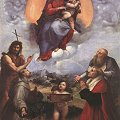 Get
Get  a high-quality picture of
The Madonna of Foligno for your computer or notebook. ‣
The painting was executed for Sigismondo de' Conti in 1511-12. It represents the Madonna in Glory but it is usually called the Madonna of Foligno.
a high-quality picture of
The Madonna of Foligno for your computer or notebook. ‣
The painting was executed for Sigismondo de' Conti in 1511-12. It represents the Madonna in Glory but it is usually called the Madonna of Foligno.
Raphael's pictorial research had been enriched by his solutions regarding the use of light in the Expulsion of Heliodorus and the Liberation of St Peter. These pictorial devices reappear in the Madonna of Foligno, now in the Vatican Museum. The Madonna and Child, borne by a cloud of angels and framed by an orange disk, dominate the group of saints below them, among whom is the donor. This group includes - from left to right - St John the Baptist, St Francis, Sigismondo de' Conti and St Jerome. A small angel at the centre of the composition holds a 'small plaque which was originally intended to carry the dedicatory inscription.
The painting was commissioned to commemorate a miracle in which the donor's house in Foligno was struck by lightning or - according to another version - was struck by a projectile during the siege of Foligno, although it was not damaged. The stormy atmosphere of the landscape background and the flash of lightning (or explosion) which strikes the Chigi Palace (visible at left) illustrate the legend. The strong characterization of the figures, the volumetric fullness of the putti and the refined chiaroscuro distinguish the panel (which was taken as loot by Napoleon's army in 1799 and returned in 1815) as a work of the mature artist.
Madonna dell'Impannata (1514)
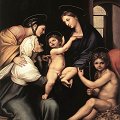 Get
Get  a high-quality picture of
Madonna dell'Impannata for your computer or notebook. ‣
In the mid-1510s Raphael had passed from the highly synthetic and expressive compositions of the first years of the decade to representations which were more and more complex and even more dispersive. Most of these were also finished by his pupils, for this was the busiest moment in Raphael's career.
a high-quality picture of
Madonna dell'Impannata for your computer or notebook. ‣
In the mid-1510s Raphael had passed from the highly synthetic and expressive compositions of the first years of the decade to representations which were more and more complex and even more dispersive. Most of these were also finished by his pupils, for this was the busiest moment in Raphael's career.
The Madonna dell'Impannata in the Pitti Gallery in Florence was also painted with the help of assistants. According to some critics, the assistants executed the entire painting. But others see the master's hand at least in the major figures (some say in the Christ Child, some in St Elizabeth, some in both figures). The composition is innovative in respect to the usual iconography of the holy family. It shows St Catherine, St Elizabeth, Christ, the Virgin and St John gathered together in a group. A large tent is visible in the background and a window covered by linen (the impannata, or cloth covering of a window, which gives the painting its name) can be seen at the extreme right. Like many other works by Raphael, this painting was carried off by the French in 1799 and was not returned until after the Congress of Vienna, in 1815.
Madonna della Seggiola (Sedia) (1514)
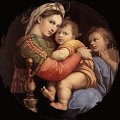 Get
Get  a high-quality picture of
Madonna della Seggiola (Sedia) for your computer or notebook. ‣
Raphael painted the picture in Rome, probably during the period immediately after the completion of the Stanza di Eliodoro. It soon passed into the Medicean collections. It was already there by 1589 and has been in the Pitti since the 18th century. It was carried off to Paris by the Napoleonic troops in 1799 and brought back to Florence in 1815.
a high-quality picture of
Madonna della Seggiola (Sedia) for your computer or notebook. ‣
Raphael painted the picture in Rome, probably during the period immediately after the completion of the Stanza di Eliodoro. It soon passed into the Medicean collections. It was already there by 1589 and has been in the Pitti since the 18th century. It was carried off to Paris by the Napoleonic troops in 1799 and brought back to Florence in 1815.
A celebrated picture in which Raphael is under the influence of the antique and of the Venetian school, of Titian and of Sebastiano del Piombo. The form of a "tondo" is in itself a reminder of Florence and carries us back to the taste of the Quattrocento. Of the form of the tondo the artist preserves and emphasizes the curve with his genial adaptation of the figures to the outline of the painting. And yet the composition is in no way forced, but on the other hand the figures in following the curve become more closely entwined together. This grouping, this closing around the fulcrum of the tondo coincides with the centre of affection - the little Christ, the spiritual centre of the picture. The colour, in spite of its vividness, has a fusion and a warmth which Raphael attains with genial and personal mastery.
Madonna della Tenda (1514)
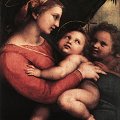 Get
Get  a high-quality picture of
Madonna della Tenda for your computer or notebook. ‣
Many critics associate the composition of the Madonna della Seggiola (Sedia) with that of the Madonna della Tenda (so called because of the green curtain that has been drawn to one side, and which forms the background) in the Alte Pinakothek of Munich. Here again the Madonna is shown in a three-quarters view with the Child and the young St John. But a relationship exists among the figures which is absent in the Madonna della Sedia. The Virgin smiles at her Child, whose attention is turned toward St John. The face of the latter bears an expression of loving devotion.
a high-quality picture of
Madonna della Tenda for your computer or notebook. ‣
Many critics associate the composition of the Madonna della Seggiola (Sedia) with that of the Madonna della Tenda (so called because of the green curtain that has been drawn to one side, and which forms the background) in the Alte Pinakothek of Munich. Here again the Madonna is shown in a three-quarters view with the Child and the young St John. But a relationship exists among the figures which is absent in the Madonna della Sedia. The Virgin smiles at her Child, whose attention is turned toward St John. The face of the latter bears an expression of loving devotion.
The authenticity of the painting is no longer in question. What remains controversial is whether it was executed before or after the Madonna della Sedia.
By comparing Raphael's mature works to one another, one detects a process of continuous growth, of stylistic evolution. The elements used are always new, as is the pictorial style. But the master's extraordinary capacity to harmonize the composition and the formal beauty of the figures, made more evident by the expression of serene emotion, are unifying motifs.
The Sistine Madonna (1514)
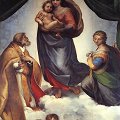 Get
Get  a high-quality picture of
The Sistine Madonna for your computer or notebook. ‣
The canvas with the Virgin, Child and Saints Sixtus and Barbara, usually called the Sistine Madonna, is characterized by an imaginary space created by the figures themselves. The figures stand on a bed of clouds, framed by heavy curtains which open to either side. The Virgin actually appears to descend from a heavenly space, through the picture plane, out into the real space in which the painting is hung. The gesture of St Sixtus and the glance of St Barbara seem to be directed toward the faithful, whom we imagine beyond the balustrade at the bottom of the painting. The Papal tiara, which rests on top of this balustrade, act as a bridge between the real and pictorial space.
a high-quality picture of
The Sistine Madonna for your computer or notebook. ‣
The canvas with the Virgin, Child and Saints Sixtus and Barbara, usually called the Sistine Madonna, is characterized by an imaginary space created by the figures themselves. The figures stand on a bed of clouds, framed by heavy curtains which open to either side. The Virgin actually appears to descend from a heavenly space, through the picture plane, out into the real space in which the painting is hung. The gesture of St Sixtus and the glance of St Barbara seem to be directed toward the faithful, whom we imagine beyond the balustrade at the bottom of the painting. The Papal tiara, which rests on top of this balustrade, act as a bridge between the real and pictorial space.
The painting was probably intended to decorate the tomb of Julius II, for the holy pope Sixtus was the patron saint of the Della Rovere family and St Barbara and the two winged 'genii' (visible at the bottom of the picture space) symbolize the funeral ceremony. The canvas was located in the convent of St Sixtus in Piacenza and was later donated by the monks to Augustus III, King of Saxony. It was carried to Moscow after the Second World War, and was later returned to Dresden.
Generations of visitors to the Gemeldegalerie in Dresden have been deeply impressed by the way in which Raphael portrayed the Madonna in this painting. It has been reproduced over and over again, and almost everyone is familiar with the putti leaning on the balustrade. The Madonna appears from behind a curtain, confident and yet hesitant. The curtain gives the illusion of hiding her figure from the eyes of the onlooker and at the same time of being able to protect Raphael's painting.
Raphael Art

|
|
More
Articles
 Art Encyclopedia A world history of art in articles.
Art Encyclopedia A world history of art in articles.
Renaissance
Raphael
Art, life and biography.
Frescoes in rooms of Vatican.
Religious paintings.
Madonnas.
Portraits.
Art
 Art Wallpapers Art image collections for your desktop.
Art Wallpapers Art image collections for your desktop.
Della Francesca Art, $19
(95 pictures)
Da Vinci Art, $25
(80 pictures)
Michelangelo Art, $29
(180 pictures)
Raphael Art, $25
(125 pictures)
Titian Art, $29
(175 pictures)
Durer Art, $25
(120 pictures)

